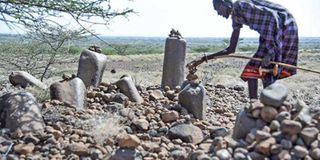Turkana dancing shrine where the wayward turned into stones

Mr Eroo Lotokoromoe, an elder, places pebbles on Namorutunga stones in Lomanmana village in Turkana County on January 19, 2020. The stones are said to be the remains of elders who were cursed during a dance. PHOTO | JARED NYATAYA | NATION MEDIA GROUP
What you need to know:
- The Namorutunga shrine is considered one the greatest Turkana heritage sites and sacred place.
Folklore has it that the ancestors were joined by their earthly god for a renowned traditional dance, Edong’a, which is performed at nightfall to celebrate their economic gains.
They were follow stern instructions from the lead dancer, lest a curse befalls them.
Some 30km on the north-west outskirts of Lodwar town, enroute to Lake Turkana, is Kalokol shrine.
The shrine, also referred to as Namorutunga by the locals, is believed to be home to the ancestors of the Turkana community, who lived over 4,000 years ago.
The Namorutunga shrine is considered one the greatest Turkana heritage sites and sacred place, and folklore has it that the ancestors were joined by their earthly god for a renowned traditional dance, Edong’a, which is performed at nightfall to celebrate their economic gains.
Elderly members of the community, both male and female, take part in the dance, which includes admiring their fattened bulls.
They also have to follow stern instructions from the lead dancer, lest a curse befalls them.
Among the instructions is caution against mocking the earthly god, including his dressing code and dancing style.
But in one of the dances at Namorutunga, the villagers are said to have defied the orders and ridiculed their god, with some of them fouling the air while he danced and they were turned into stones.
The smooth stones are in different positions; some standing, others believed to be running away and some lying on their bellies or squatting.
“These are our frozen ancestors who were transformed into stones after they ridiculed our god as he danced,” said Mr Titus Ekiru, a culture expert in Turkana County.
The stones evoke images of ancestors up to date and there are plans by the county government to market the site as a Turkana cultural and historical site and tourist destination.
“Whoever visits the site is expected to place four stones on top of the frozen ancestors to appease them and whoever takes away the smooth stones invites a curse,” Mr Ekiru said.
But the historical and cultural site is facing a threat from individuals who have been assembling the stones for building and construction purposes.
“This shrine forms our rich heritage and measures need to be put in place to protect the stones from being taken away by individuals who consider them a source of income,” said Mr Eroo Lotokoromoe, an elder at Namoturunga village.
According to the elder, the Turkana used to erect large stones in which they buried their dead but culture has since changed and they now bury their loved ones in coffins.
“The increased demand for stones for construction purposes is proving to be a major threat to the survival of this shrine and the current generation should sensitised on its values,” said Mr Lotokoromoe.
Lodwar town and its environs are experiencing rapid transformation with the mushrooming of high-rise buildings, whose building material are sourced from the Turkana basin, including Namorutunga village.
Is there a site you want us to feature? Write an email to [email protected]






